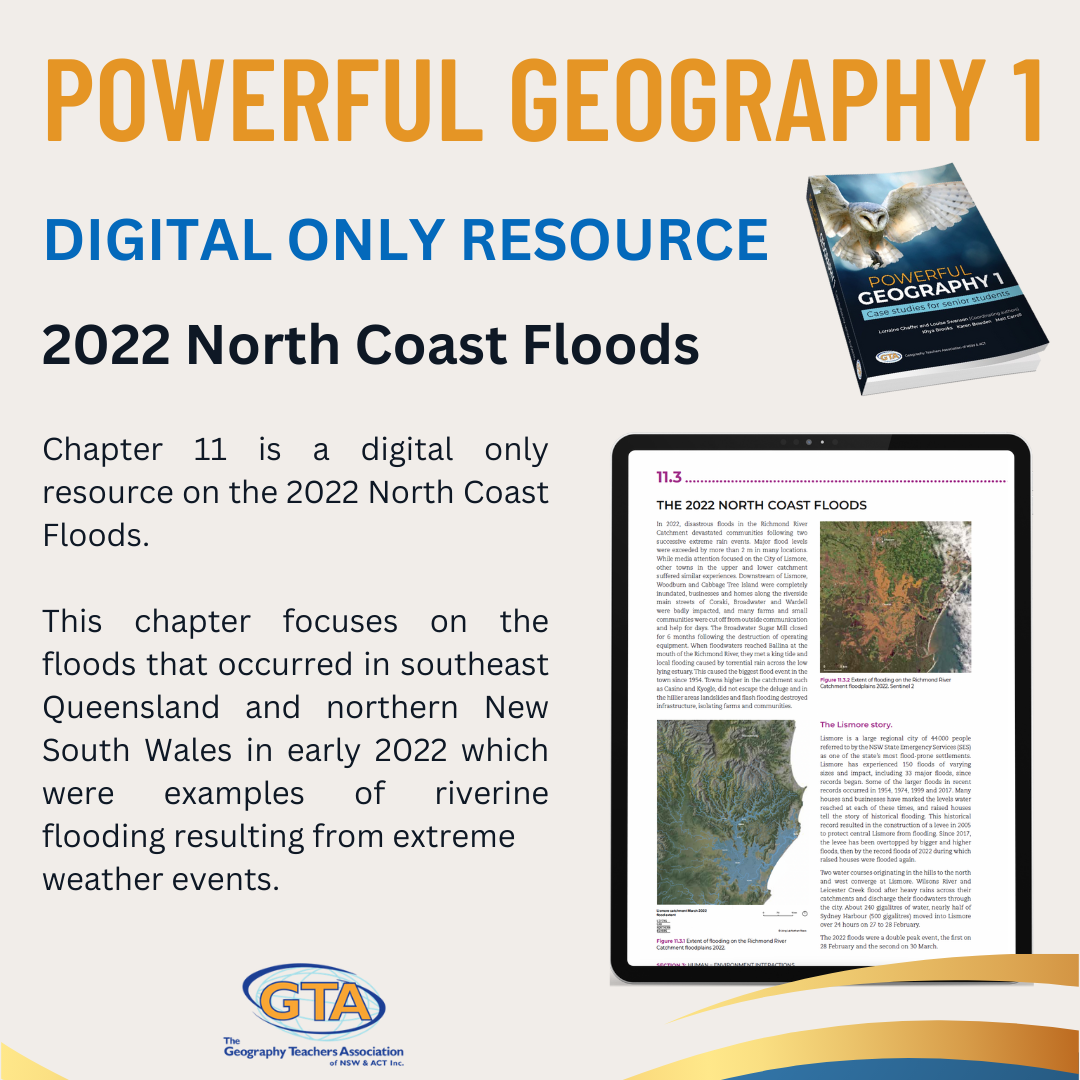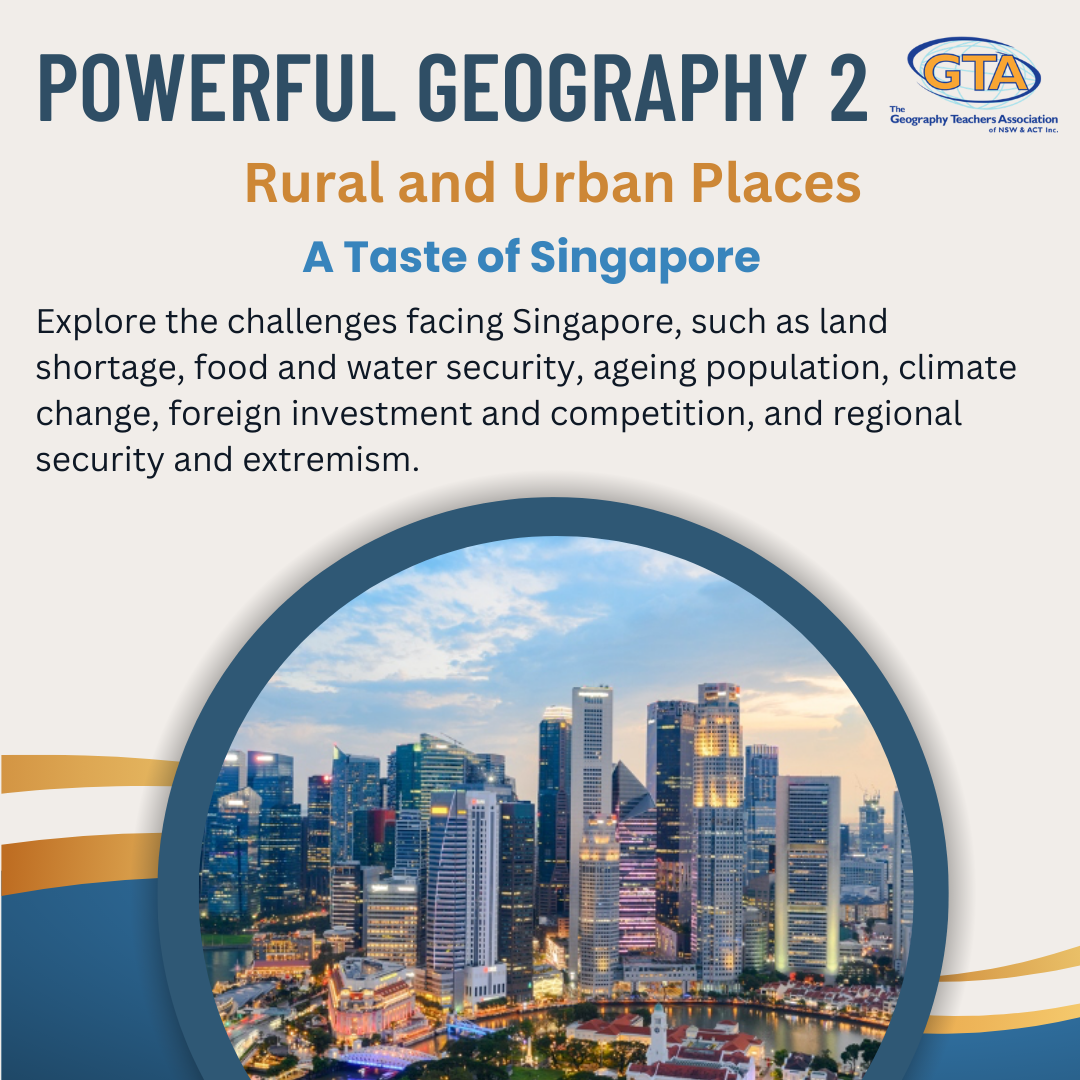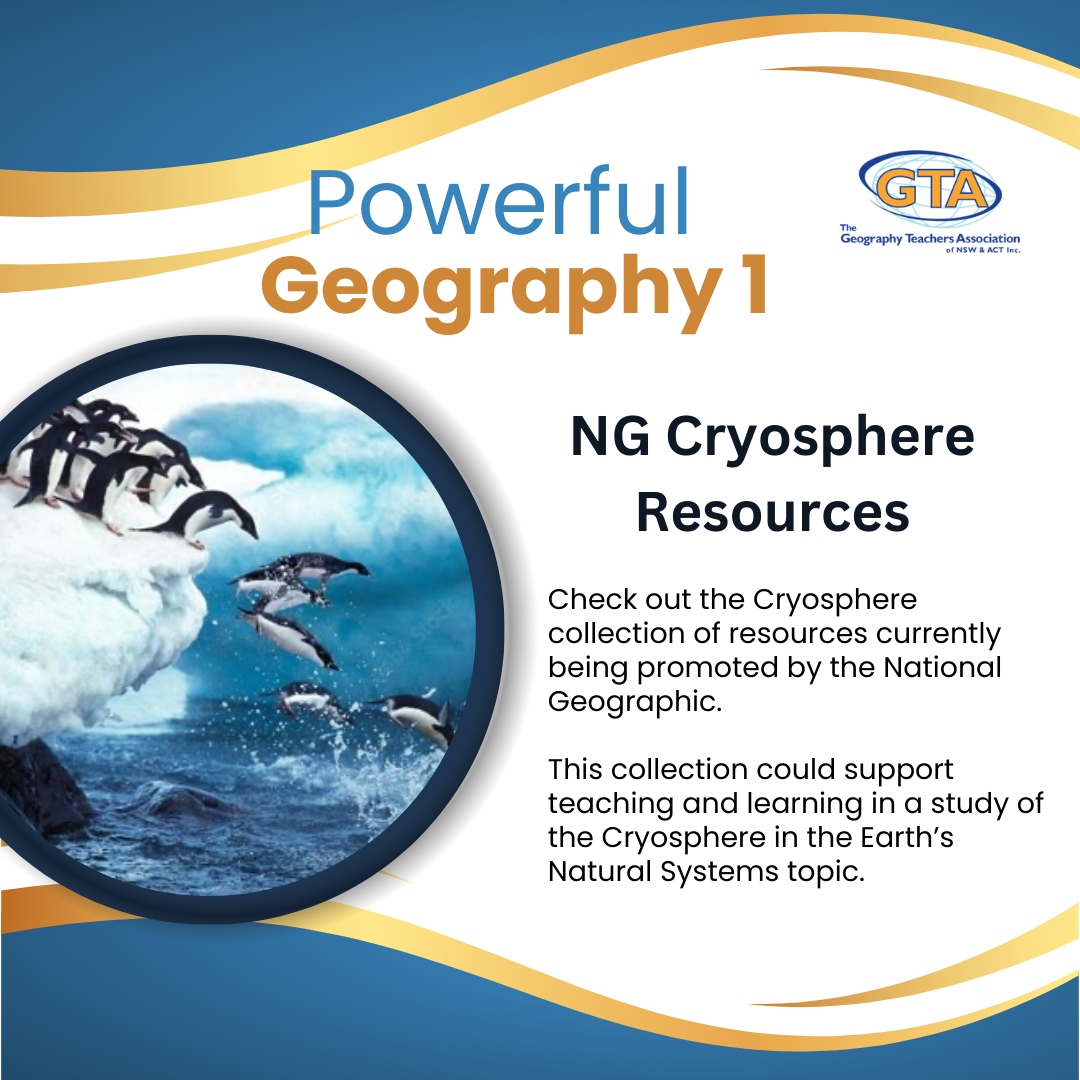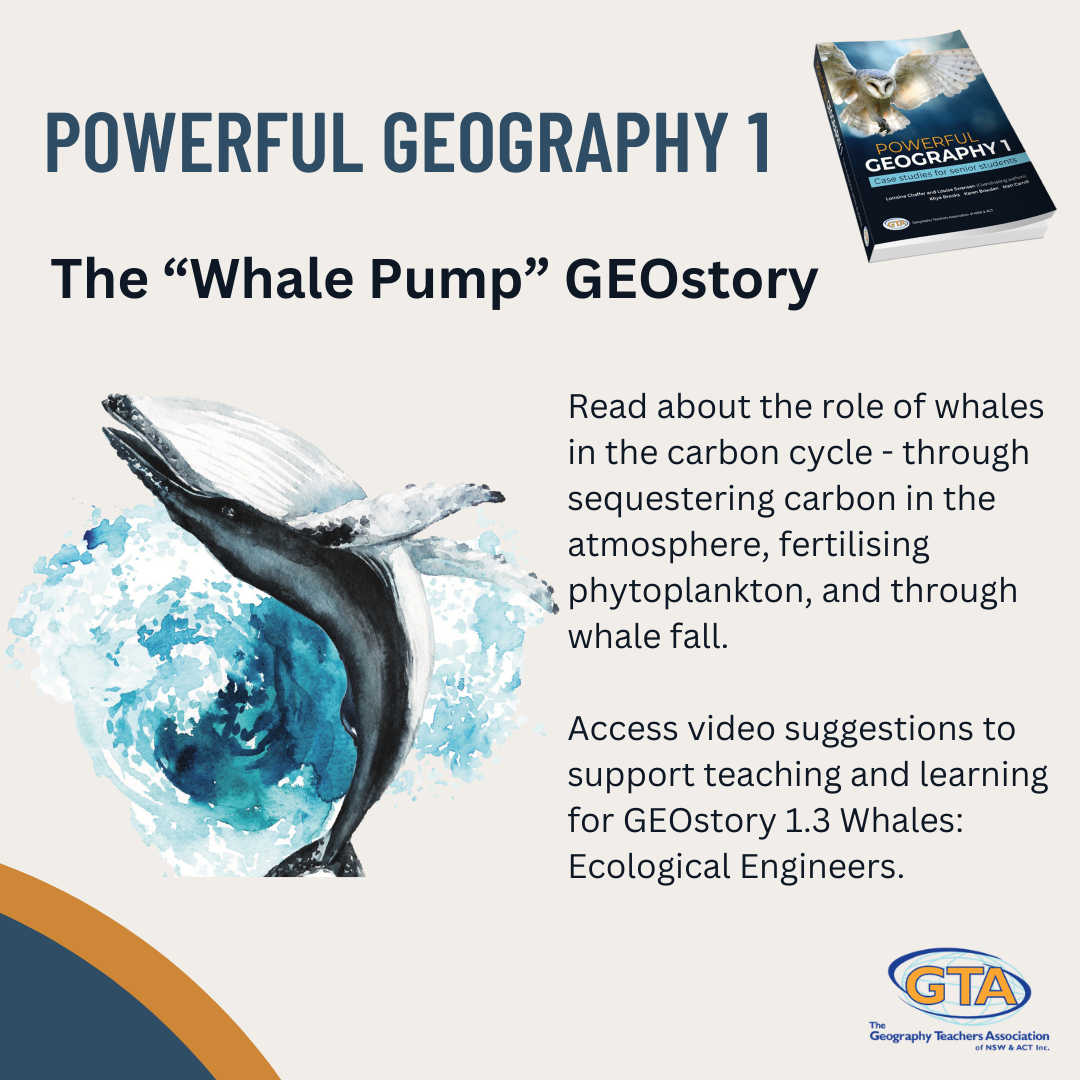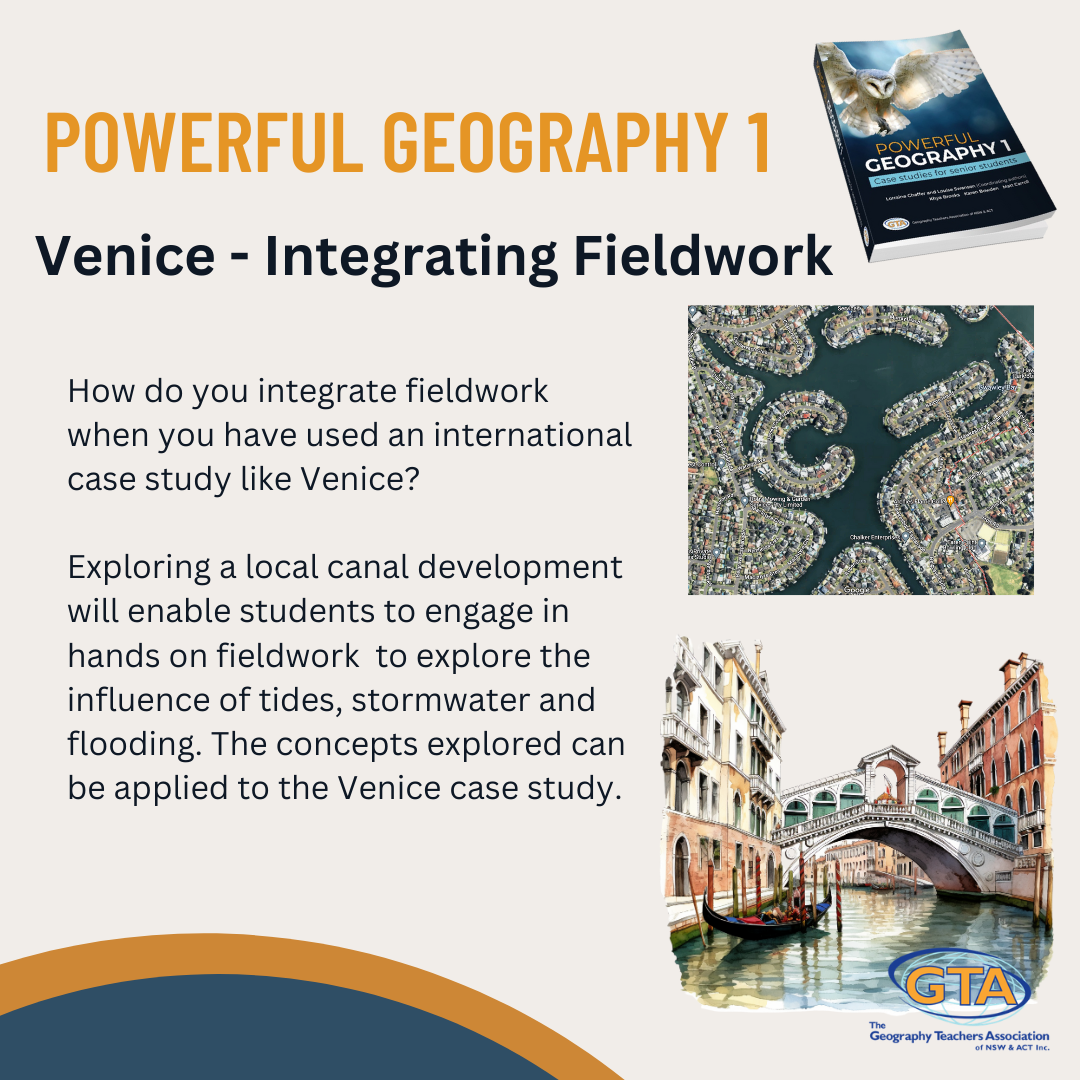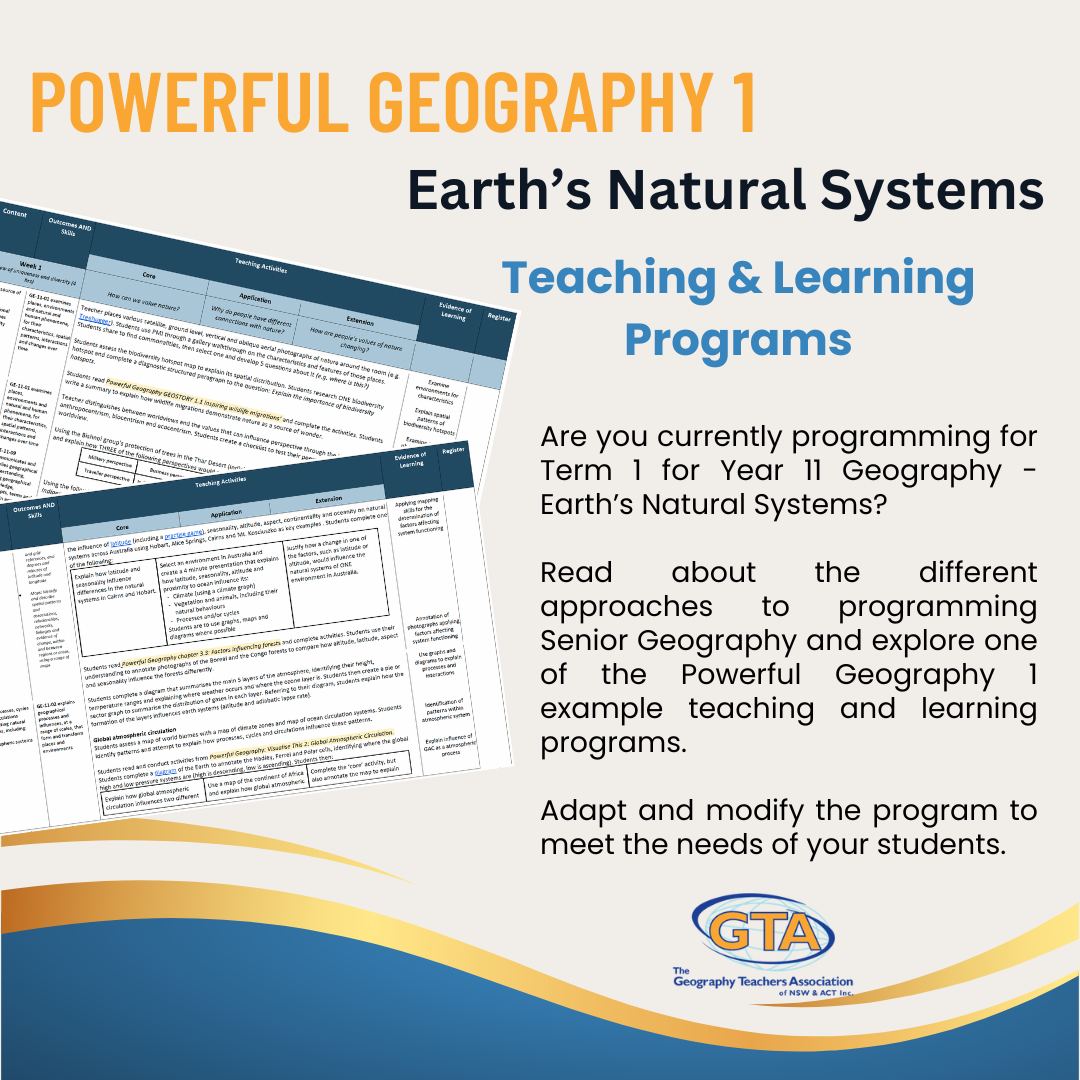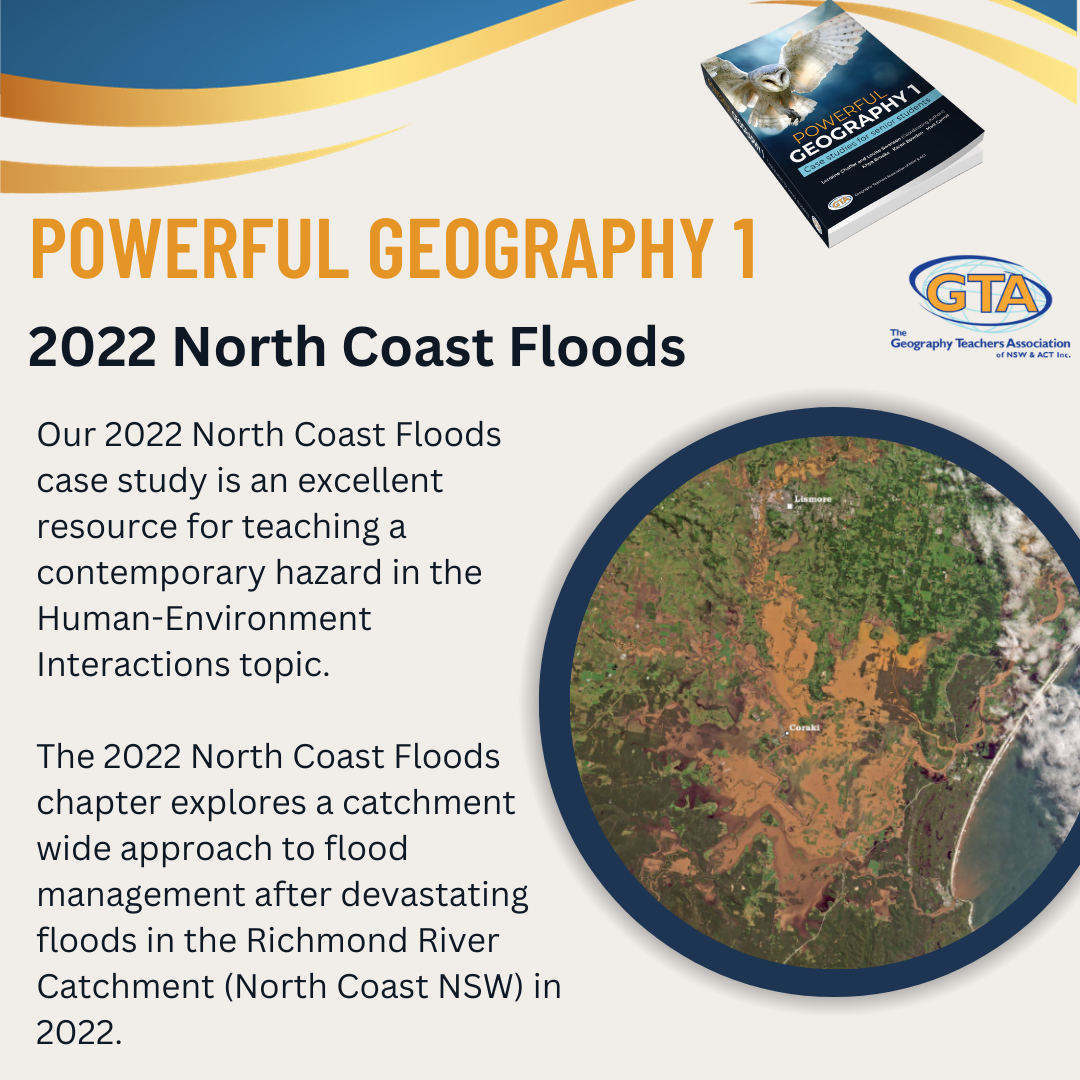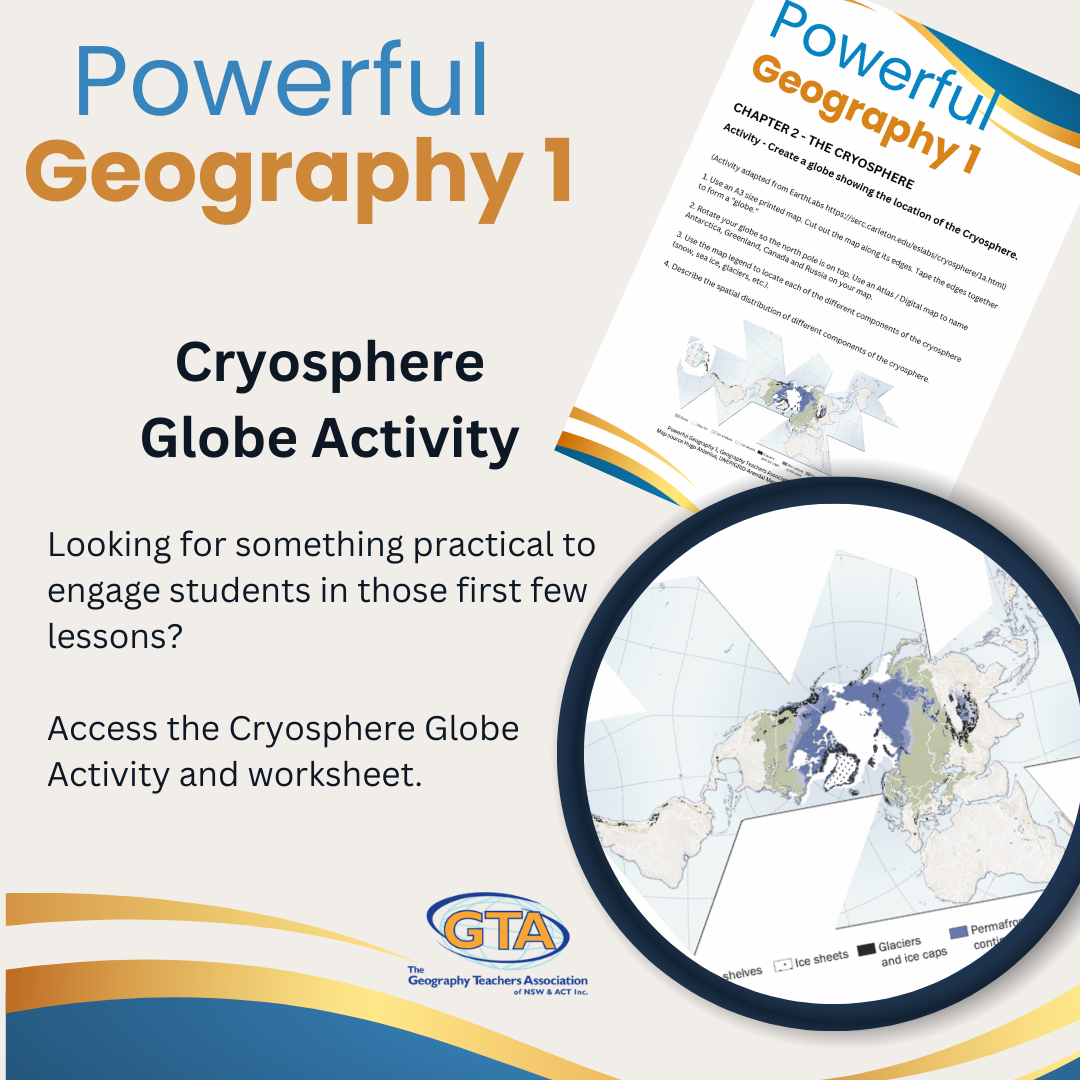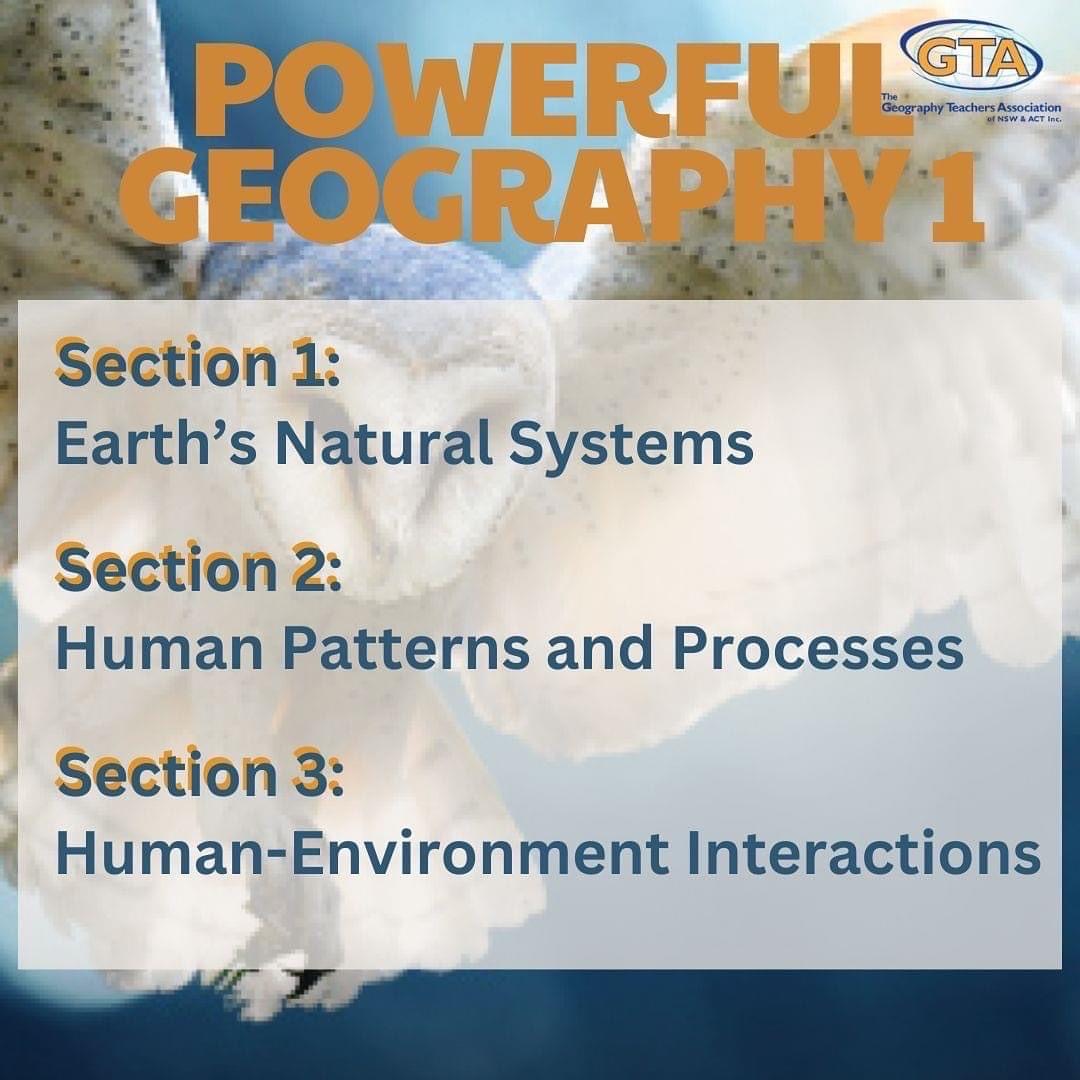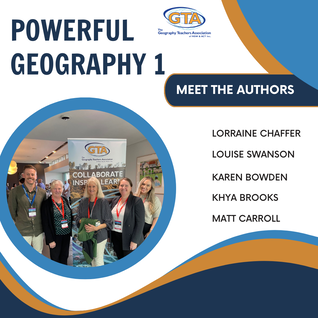This site will support teachers in delivering the new NSW Senior Geography syllabus. The Powerful Geography authors will provide updated resources, student activities and links to supporting material. This will help teachers maintain current teaching knowledge and materials and provide an up-to-date, adaptive teaching resource to student ensure engagement and success in Senior Geography.
blog posts list
|
Year 11
Earth's Natural Systems Linked Content - The Arctic The Cryosphere - Integrating Fieldwork Cryosphere Globe Activity NG Cryosphere Resources The Iceberg model Forests - Integrating Fieldwork Forest Infographics Earth's Natural Systems - Teaching and Learning Programs Earth's Natural Systems - Teaching and Learning Program 2 Inspirational Wildlife Migrations Forest Elephants - GEOstory Ecological Systems and Succession The "Whale Pump" GEOstory Value of Dust GEOstory Earth as an Interconnected System of Systems People, Patterns and Processes Venice Case Study Venice - Integrating Fieldwork 2022 North Coast Floods Northern NSW Floods - Integraring Fieldwork People, Patterns and Processes - Integrating Fieldwork Digital Only Resource - Global Networks - Eye in the Sky Human-Environment Interactions Climate Change and Social Justice Climate Change - Small Island States Climate Change in the Arctic Melting Ice and Arctic Shipping Routes Digital Only Resource - 2022 North Coast Floods |
Year 12
Preparing for HSC Geography Implementation Global Sustainability Global Banana Industry Fashion Industry Salmon Aquaculture Rural and Urban Places A taste of Singapore - A Large City Outside Australia Singapore -Underground Spaces Ecosystems and Global Biodiversity Shark Finning in the Coral Triangle Live Fish Trade and Cyanide Fishing Coral Triangle - Whale Shark Tourism Marine Protected Areas - Sipidan Island Park |
blog contents
|
Preparing for HSC Geography Implementation
As you are programming for the HSC year, this is a good time to explore the case studies and concepts covered in Powerful Geography 2. Explore the case studies and concepts covered in Powerful Geography 2. Read this post... |
|
Digital Only Resource - 2022 North Coast Floods
In the Human-Environment Interactions Preliminary unit there are three study options from which to choose. The 2022 North Coast Floods chapter addresses Study 2: A contemporary hazard. This chapter is a digital only resource available only to purchasers of the text book. Read this post... |
|
Digital Only Resource - Global Networks - Eye in the Sky
In the People, Patterns and Processes Preliminary unit there are five study options from which to choose. The Global Networks - Eye in the Sky GEOstory addresses Study 5: Technological advances and the transformation of places. This is a digital only resource available to purchasers of the text. Read this post... |
|
Climate Change - Tuvalu and Kiribati
Powerful Geography 1 includes a chapter on Climate Change and Small Island States to address the Climate Change study of the Human-Environments Interactions Preliminary topic. This blog provides links to videos and articles about the impact of climate change on Tuvalu and Kiribati. Read this post... |
|
Climate Change - Small Island States
Powerful Geography 1 includes a chapter on Climate Change and Small Island States to address the Climate Change study of the Human-Environments Interactions Preliminary topic. This blog provides links to a range of videos and articles to support teaching and learning of this topic. Read this post... |
|
Climate Change in the Arctic
Powerful Geography 1 includes a chapter of the Arctic to address the Human-Environment Interactions topic as a case study of a geographic region. The Arctic has warmed by an average of 3°C over the past four decades – nearly four times faster than the rest of the world. Explore videos and articles to support teaching of the Arctic as a geographic region, and the impacts of climate change. Read this post... |
|
Melting Ice and Arctic Shipping Routes
Powerful Geography 1 includes a chapter of the Arctic to address the Human-Environment Interactions topic as a case study of a geographic region. Warming seas and melting ice are changing shipping routes. In this blog post explore links to articles and a video to support student learning about the geopolitical implications of changing shipping routes as a result of climate change. Read this post... |
|
Singapore Responses - Underground Spaces
Powerful Geography 2 includes a chapter on Singapore as a large city outside of Australia. Explore how Singapore uses underground spaces to extend useable space, address sustainability and improve quality of life. Access a video about use of underground spaces in Singapore. Read this post... |
|
A Taste of Singapore - A Large City Outside of Australia
Explore the challenges facing Singapore, such as land shortage, food and water security, ageing population, climate change, foreign investment and competition, and regional security and extremism. Access a video about the challenges facing Singapore. Read this post... |
|
Choosing Your Ecosystem Case Studies
There is still some confusion about what is required in this topic. What do you need to do? This blog post provides guidance about the number, location and types of case studies required, and provides guidance on how to choose the best ones. Read this post... |
|
Marine Protected Areas - Sipidan Island Park
Explore Sipidan Island Park as an example of a Marine Protected Area in the Coral Triangle. This is an additional illustrative example to that provided in the Powerful Geography 2 text. Sipidan Island Park is located on the east coast of Malaysian Borneo in the Celebes Sea, and has hundreds of coral species and more than 400 fish species. Read this post... |
|
Coral Triangle - Whale Shark Tourism
Whale shark tourism in Oslob in the Philippines, has become an excellent alternative source of income for locals. The Whale Shark watching tours hire local fishermen who feed the whale sharks small amounts of food to encourage them to stay in the area and stay close to the boats carrying the tourists. Read this post... |
|
Live Fish Trade and Cyanide Fishing
The live fish trade involves capture of live fish, and transportation to restaurant tanks thousands of kilometres away from the location of capture. International trade in live reef fish in the Indo-Pacific region is driven by the demand for ultra-fresh seafood. Live reef fish trade is estimated at between 20,000 and 30,000 metric tonnes a year. Read this post... |
|
Shark Finning in the Coral Triangle
Sharks are apex predators which remove sick and weak organisms and regulate ecosystem functioning. Shark numbers are in decline globally, with some species near extinction. Habitat loss, lack of fish in degraded areas and shark finning are key factors in declining numbers. Tens of thousands of sharks are killed every year. Read this post... |
|
National Geographic Cryosphere Resources
Check out National Geographic's Cryosphere collection. This could be used to support your teaching of the Cryosphere study in the Earth's Natural Systems topic. Read this post.... |
|
Understanding Earth as an Interconnected System of Systems
Watch a presentation from the AdaptNSW Conference by Leith Sharp. They demonstrate the interconnectedness of nature, including the connection of each individual to Earth’s natural processes. Read this post... |
|
Value of Dust - GEOstory
Explore the global movement of dust and how it links processes, cycles and circulations. Access video suggestions for GEOstory 1.4 Blown Away: The Story of Dust. Read this post... |
|
The "Whale Pump" GEOstory
Explore how whales change climate, engineer the ecosystem, create conditions that spawn plankton, and keep our oceans healthy. Access video suggestions to support teaching and learning of GEOstory 1.3 Whales: Ecological Engineers Read this post... |
|
Forest Infographics
Forests link all of Earth's natural systems and can be used to explain key concepts related to atmospheric, hydrological and oceanic processes, cycles and circulations, as well as ecological succession. Explore infographics about Forest Sytems. Read this post... |
|
The Iceberg model
Use the Iceberg model for discussing and writing about natural events such as the yearly iceberg appearances in Newfoundland. This model supports teaching of GEOstory 1.5: Iceberg Alley. Read this post... |
|
Ecological Systems and Succession
Building conceptual understanding is important for student success. Visual representations can help student understanding. Explore some of the illustrations to support learning of ecological systems and succession. Read this post... |
|
Cryosphere - Globe Activity
Looking at teaching the Cryosphere for the Earth's Natural Systems topic? Access a video about Patagonia, and the Cryosphere Globe Activity and worksheet to help engage your students in the Cryosphere topic. Read this post... |
|
Forest Elephants: Valuing Nature
The Earth's Natural Systems topic explores characteristics of natural systems and factors affecting their functioning, as well as processes, cycles and circulations connecting natural systems. The Forest Elephants: Valuing Nature GEOstory explores the role of African forest elephants, their dung in the forest ecosystem and the value of elephants in carbon capture. Read this post... |
|
Inspirational Wildlife Migrations
The Earth's Natural Systems topic includes an examination of nature as a source of wonder, and characteristics of natural systems. The Inspirational Wildlife Migrations GEOstory explores the migrations of Bar-Tailed Godwit, Loggerhead Turtle and Wildebeest, Caribou and Bison. Read this post... |
|
Earth's Natural Systems - Cryosphere Teaching and Learning Program
Access our Earth's Natural Systems Teaching and Learning Program 2 (PDF and Word documents available for download). Students learn about processes, cycles and circulations connecting Earth’s Natural Systems through a study of the Cryosphere and a place study of Patagonia. Read this post... |
|
Human-Environment Interactions
The Northern NSW Floods is a case study to explore the Human-Environment Interactions topic. This case study lends itself to local fieldwork or a multi-day fieldtrip. Explore how you can integrate fieldwork into your teaching and learning program to enhance teaching of the Northern NSW Flood case study. Read this post... |
|
People, Pattern and Processes - Venice - Integrating Fieldwork Venice's canal system is one of the most unique of its features. Classes could undertake fieldwork at a canal development such as Sylvania Waters, Ballina, Tweed Heads, Currumbin, Forster, Tweed Heads, Yamba. Read about undertaking fieldwork at a local canal development and applying knowledge and skills to the Venice case study. Read this post... |
|
People, Patterns and Processes - Integrating Fieldwork
Where could you undertake fieldwork on Population and Resource Consumption? What kind of fieldwork activities could you carry out? Read about integrating fieldwork into the People, Patterns and Processes topic in our new blog post. Read this post... |
|
Earth's Natural Systems - Teaching and Learning Programs
The NESA Teaching advice suggests two possible approaches to teaching Earths Natural Systems. This blog post explores those two approaches and provides a detailed teaching and learning program for Earth's Natural Systems. Explore our example teaching and learning program for Earth’s Natural Systems. Read this post... |
|
Climate Change and Social Justice
Investigating contemporary issues allows students to move beyond knowing the facts, understanding processes and providing examples - to analysis and critical thinking. The case study for Climate Change focuses on Pacific Small Island Developing States (SIDS) who are among some of the most vulnerable nations in the world to the impacts of climate change. Read about Climate Change and the Pacific Small Island Developing States in this new blog: Read this post... |
|
2022 North Coast Floods Case Study
What physical characteristics of the Richmond River Valley make it vulnerable to flood? What land cover changes in the catchment increase vulnerability to flood? Can re-swamping the swamp save Lismore and other towns from floods? Should Lismore move? Why do fish kills follow floods? Read about our North Coast Floods Case study in this new blog post. Read this post... |
|
Forests - Integrating Fieldwork.
Read about opportunities to integrate fieldwork in the Forests case study for the Earth’s Natural Systems topic. Forests provide habitats for more than three-quarters of life on land. They are the largest terrestrial carbon sink, absorbing 2 billion tonnes of carbon dioxide per annum. The Boreal forest of Canada and... Read this post... |
|
Cryosphere - Integrating Fieldwork
The Cryosphere is one of the longer case studies in the Earth's Natural Systems section of Powerful Geography 1. This topic would be an excellent opportunity for a overnight trip to Kosciuszko National Park, where you may be able to visit sites which demonstrate evidence of glaciers such as Moraine Pass, Blue Lake, Albina Cirque, Club Lake or Lake Cootapatamba. Read this post... |
|
What does Powerful Geography Look Like?
Look at a few of the Powerful Geography 1 Sample Pages. Read about how the layout and design of this resource will help engage your students and facilitate their learning. Read this post... |
|
Linked Content - The Arctic
To build conceptual knowledge and understanding and to ensure maximum usability of Powerful Geography content, a conscious effort was made to link content. Read about how a study of the Arctic links with a range of interconnected Visualise This, GEOstories and case studies. Read this post... |
|
Venice Case Study
The Venice case study in Powerful Geography 1 addresses the "People, patterns and processes" topic in the preliminary course. It has been written to address Study 1: Human resilience in diverse environments. Read this post... |
|
What is the purpose of GEOstories?
GEOstories have been written to supplement the content for each Content Focus Area. These stories range in size from a couple to several pages and include supporting illustrative material. The stories go beyond the narrative to engage with geographical content, tools, skills, and concepts. Read this post... |
|
Choosing Your Case Studies
As Geographers we are blessed for choice with case studies. However, there are many things to consider when selecting a case study for the new Geography syllabus 11-12. What studies were completed in years 7-10? It’s worth backward mapping to avoid repetition and boredom, and to build conceptual understanding through new studies. Are there fieldwork opportunities? If I do an overseas case study, how can I integrate fieldwork? What tools and skills do I want or need to develop? Read this post... |
|
What is the purpose of Visualise This?
Sometimes there is a need to spend more time on a concept to ensure students understand what it means and can apply it in context. Each Visualise This looks at a concept using visual tools such as diagrams, illustrations, maps and graphs. Read this post... |
|
What's in Powerful Geography 1?
Powerful Geography 1 is written for the Preliminary year of the new Senior Geography syllabus. It includes contemporary case studies, GEOstories (micro case studies) and Visual This (key concepts explained using illustrations. It also includes a variety of student activities to cater for a range of student abilities. An outline of the contents of Powerful Geography 1 is outlined below. Read this post... |
|
Introducing Powerful Geography
Our team of authors are excited to introduce you to Power Geography - a set of books to support teaching Senior Geography in NSW. The new NSW NESA Senior Geography syllabus will be implemented in Year 11 in 2024 and in Year 12 in .... Read this post.... |
socials
Follow us on Instagram (@powerfulgeography) and Facebook (Powerful Geography)


